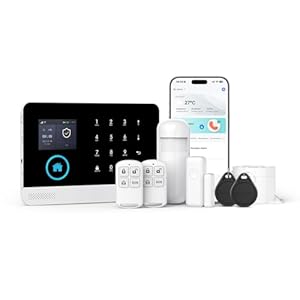
When considering wireless smart security systems, you may find yourself intrigued by the convenience they offer in terms of installation and flexibility. However, it’s essential to weigh the potential drawbacks, such as vulnerabilities to interference and cybersecurity threats. As you explore the pros and cons of these systems, you’ll uncover a nuanced landscape of considerations that can impact the effectiveness of your home security.
Advantages of Wireless Smart Security Systems
When considering wireless smart security systems, you may appreciate their convenience and flexibility in installation. These systems are easy to set up since they don’t require any complicated wiring or drilling into walls. With wireless technology, you can place sensors and cameras wherever needed without being limited by the constraints of traditional wired systems. Additionally, wireless smart security systems offer remote access, allowing you to monitor your home from anywhere using your smartphone or computer. This feature provides peace of mind, especially when you’re away from home and want to check on your property in real-time.
Moreover, wireless smart security systems are often modular, meaning you can easily expand your system by adding more devices as needed. This scalability makes it simple to customize your security setup based on your specific requirements. Furthermore, these systems are less susceptible to physical tampering, as there are no visible wires that can be cut to disable the system.
Disadvantages of Wireless Smart Security Systems
While wireless smart security systems offer various advantages, it’s important to consider the drawbacks they present as well. One significant disadvantage is the potential for wireless interference. Because these systems rely on wireless signals to communicate, they can be susceptible to disruptions from other electronic devices or even physical obstacles within the home. This interference could result in missed alerts or delayed notifications, compromising the system’s effectiveness.
Another drawback is the reliance on power sources. Wireless smart security systems require power to function, whether through batteries or electricity. If the power source fails or if batteries aren’t regularly replaced, the system could become inactive, leaving your home vulnerable.
Additionally, there are concerns about cybersecurity with wireless smart security systems. Hackers could potentially breach the system’s network, gaining access to your security cameras or alarms. This security risk poses a threat to your privacy and the overall safety of your home. It’s essential to invest in robust cybersecurity measures to mitigate this risk when using wireless smart security systems.
Factors to Consider Before Installing
Considering several key factors before installing a wireless smart security system can help ensure its effectiveness and compatibility with your home security needs.
First, evaluate the layout and size of your home to determine the number of sensors and cameras needed for adequate coverage. Additionally, assess the vulnerability of entry points such as doors and windows to determine where to place sensors strategically.
Consider the power source for the system – whether it’s battery-operated or requires a power outlet nearby. It’s crucial to ensure that your Wi-Fi signal is strong and reliable in all areas where you plan to install security devices for seamless connectivity.
Compatibility with other smart home devices and platforms should also be taken into account to create a cohesive smart home ecosystem. Lastly, consider your budget for upfront costs and ongoing monitoring fees to select a system that aligns with your financial constraints while meeting your security requirements.
Tips for Maximizing Security System Efficiency
To optimize the efficiency of your security system, ensure proper placement of sensors and cameras throughout your home. Sensors should be strategically located near entry points such as doors and windows to detect any unauthorized access. Make sure they’re positioned at the right height and angle for maximum coverage. Additionally, consider placing motion sensors in areas with high traffic to enhance detection capabilities.
When installing cameras, place them in key areas both indoors and outdoors. Outdoor cameras should cover entry points and vulnerable spots like the garage or backyards. Indoor cameras can monitor high-traffic areas like the living room or hallway. Ensure cameras have a clear line of sight and are mounted out of reach to prevent tampering.
Regularly check and maintain your security system to ensure optimal performance. Replace batteries in sensors and cameras as needed and test the system periodically to identify any issues. By following these tips and staying proactive, you can maximize the efficiency of your wireless smart security system.
Trending Products














